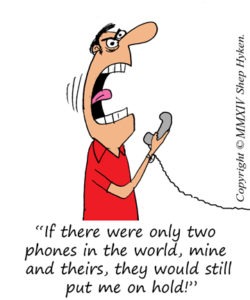 Customer Service Solutions
Customer Service Solutions
One of the worst friction points in a customer service experience is when a customer is put on hold. This is the exact point I wanted to convey to an audience at a recent meeting at which I was asked to speak. My client asked me to include a piece on hold times and transfers. I tried an interesting experiment. I invited the vice-president of marketing to the stage in the middle of the speech to deliver a special message. He walked on stage to a nice round of applause. He took center stage and looked at the audience. Once the applause ended, he just stood there in silence, and that silence was, as they say, deafening. He continued to look out into the audience, not uttering a single word, for 90 seconds. The audience became very uncomfortable. I then came back on stage, thanked him and asked the audience to give him a round of applause as he walked off stage. The audience wasn’t sure what had just happened.
I asked the audience how long he had been on stage. Many of them said three or four minutes.
No, it was just 90 seconds. It just seemed longer. I then informed the audience that 90 seconds is the average hold time the customer experiences when they call in. Point made. They got it. Even just 90 seconds is way too long to wait, especially for a company that prides themselves on an excellent customer service experience.
In preparing for this article, we connected with Steven Coufel of Software Advice, a web-based business for customer support software reviews, who shared some stats and facts that one of his colleagues, Craig Borowski, included in the article You Need to Offer Callback-Here Are 3 Ways to Get It. They surveyed more than 1,100 customers to get their take on being put on hold or being called back.
- 60% of customers feel that waiting on hold for just one minute is too long.
- 63% of consumers prefer a callback option instead of waiting on hold.
- 43% expect a callback from the company within 30 minutes.
- 28% would prefer a callback rather than even spend a minute on hold.
With all of that info, what are we to do? Fear not, there are solutions. While they still place the customer on hold, they help manage the experience and mitigate, if not even eliminate, the angst and anger. Here are a few:
- Let the customer know how long they will have to hold. Technology has the capability of letting the customer know how long the wait will be.
- Give the customer an option to be called back. I like this one. The technology will actually tell me how long before I’ll get the call-back.
- And, the Holy Grail of call backs; letting the customer choose when they want to be called back. Cool technology.
I’m one of those people who doesn’t like to waste time on hold. I appreciate the callback feature and am typically disappointed when I have to hold and there isn’t a callback option when I call for help or support. The technology is there. And it’s not that expensive. There are no more excuses. Either answer the phone or call me back.



